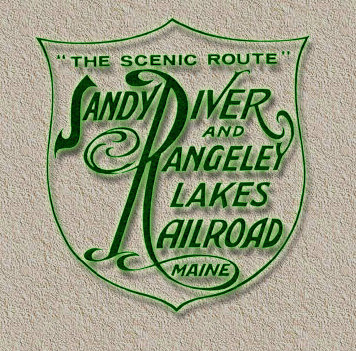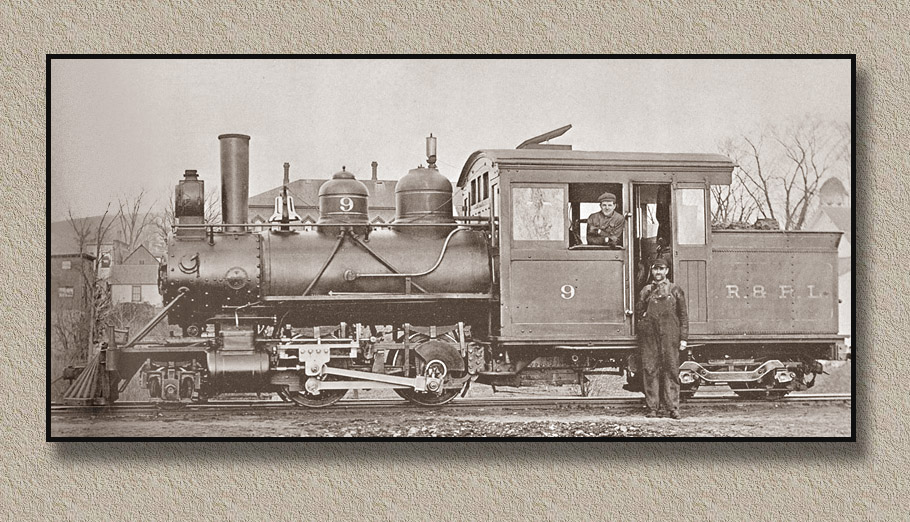Sandy River & Rangeley
Lakes Railroad Locomotive Number 9
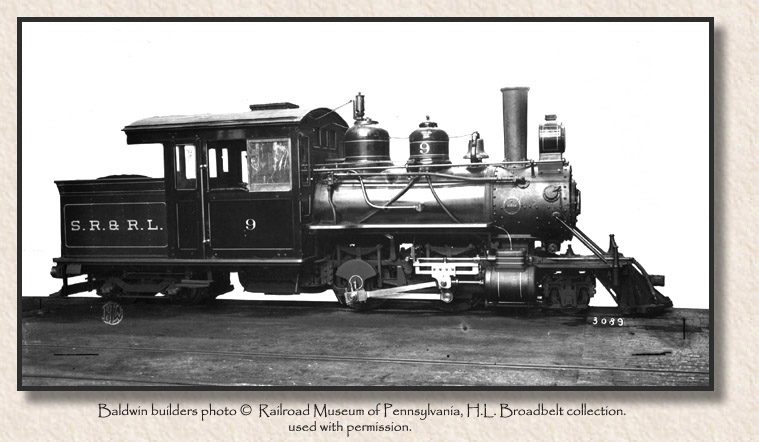
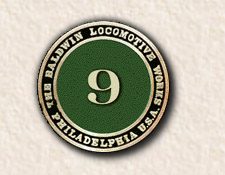
A
history of Sandy River & Rangeley Lakes locomotive No. 9.
and
building a model of No. 9 in On2 scale, from a Bachmann On30 forney.
SR&RL Number
9 arrived in Maine in 1909, built by the Baldwin Locomotive Works.
She was a sleek
and stylish passenger engine, state of the art!
She was first
fired up on July 6, 1909 (boiler test date at BLW)
and she arrived
on the SR&RL the first week of August, 1909.
Baldwin class
10-16 1/4-C6
c/n 33550
Number 9 served
her owner well, hauling the "Rangeley Express" and other trains during
her 27 year
career with the
SR&RL. She operated until the very end of the railroad in 1935, but
was sadly scrapped
a year or so
after operations ceased.
(more details
about Number 9's life can be found at the bottom of this page.)
I jumped into
Maine 2-footer On2 scale modeling in January 2006 after Bachmann
announced they were coming
out with a new
Forney in On30 scale, based on Maine 2-foot prototypes! I had to
have one! 
While waiting
for the Forney to come out, I started an On2
coach project, and also began a SR&RL #23
project. Im putting
#23 on hold for awhile while I start on the Forney..but dont worry, 23
will
be finished!
The models came
out, they are fabulous, and it became clear that Bachmann based them very
closly on SR&RL
numbers 8 and
9! (No. 8 for inside frame, No. 9 for outside frame) they arent an exact
match, but they are very close! (Bachmann says they arent technically supposed
to be models of number 8 and 9..instead they are Baldwin "catalog engines"..but
for catalog engines, they sure are a great match to numbers 8 and 9!
Thanks Bachmann!  )
)
And now...
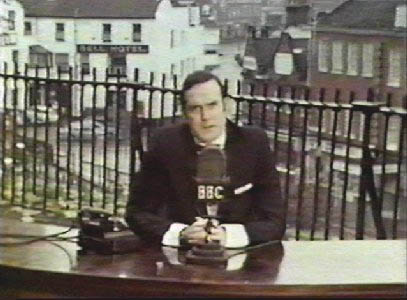
...for something
about why I must regauge to On2.
So the Bachmann
forney is On30 scale, (running on 30-inch gauge track).. which is fine..because
On30 is
becoming a very
popular scale, (and if it werent for On30 scale, this forney model wouldnt
even exist!
so you won't
fine me complaining about On30!
and most people
will probably just keep them as On30 scale..but I quickly deceided I needed
to be one of those guys who likes to make things difficult!  I just couldnt accept Maine 2-foot models running on two and a half
I just couldnt accept Maine 2-foot models running on two and a half
foot gauge track..I
choose not to accept the visual difference in the track gauge, to me, it
just looks "too wrong"....
so I must regauge!
Its a challenge,
but in my opinion its worth it..if its not worth it you, no problem! 
I do undersand
the appeal of On30, its ease of use..thats fine, its just not for me.
There has been
much disussion around "Regauge to On2 or just keep things in On30?"
the pros and
cons of each..
On30
Pro - much easier!
just run On30 trains as-is!
Con - track and
rolling stock gauge is too wide, looks wrong.
On2
Pro - track and
rolling stock gauge is correct for 2-footers in 1/48 scale! no compromises,
and it looks "right"..because it is!
Con - it's a
lot more work!
So you have to
weigh
those, and decide which is more important to you..
less work but
wrong look? (On30)
or more work
but right look? (On2)
I choose option
2.
for me, the look
outweighs the work.
obviously not
regauging is MUCH easier!
And some say
"the difference in gauge isnt really all that noticable anyway..so why
bother?"
Well..in my opinion,
the difference in gauge really IS quite noticable..
The Maine 2-footers
were very interesting and unique because they were 2-foot gauge!
If they had
all been built
to standard gauge to begin with, no one would really care about them or
even be aware of
them today..
the remains of the SR&RL and WW&F today would be just more anonymous
abandoned Maine Central branchlines. Probably the only person modeling
the original WW&F (if it had been standard gauge)
would be one
guy from Wiscassett! no one else would even be aware of it...
Take a look at
the interest in the SR&RL compared to the RF&RL..
the "Rumford
Falls and Rangeley Lakes Railroad"..
anyone here modeling
the RF&RL??  why not? it pretty much covered the same territory as the SR&RL.
why not? it pretty much covered the same territory as the SR&RL.
the difference
is that the RF&RL was standard gauge..thus, no one really cares..even
if you have heard of the
RF&RL, I
bet you cant tell me one single thing about any one of its locomotives!
(I dont know
either! thats the point..)
So 2-foot gauge
is the primary "thing" about the Maine 2-footers that made them what they
are!
it's what made
them interesting and unique, and it's what made us all "2-footer fans"
today.
isnt that a pretty
important feature to model then?? I think so..
Here is a look
at the difference between On30 and On2..
(keep in mind
that On30 technically isnt even 30-inch gauge to begin with! its actually
31-inch
gauge! )
So the difference
is not 6 inches as commonly stated..its actually 7 inches..
31 inches compared
to 24 inches.
That makes the
On2 track gauge about 75% of On30..thats siginificant enough for me.
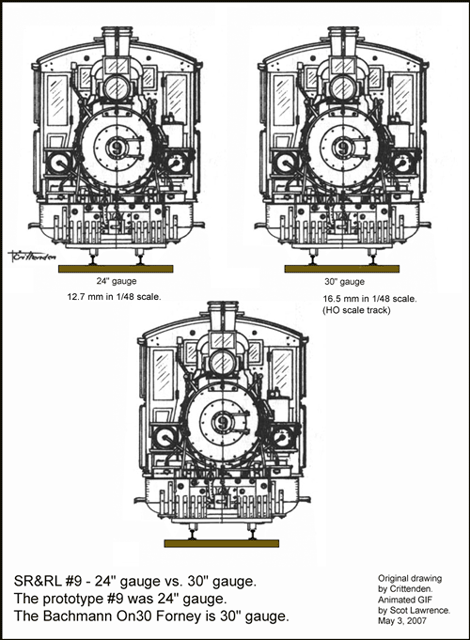
Here is a "test
track" I made, for testing models with my DCC system.
The "On30" track
is a piece of HO scale flextrack, and the On2 track is another piece of
HO scale track,
with the ties cut down the middle and re-gauged to On2.
the difference
in gauge looks quite substantial to me.
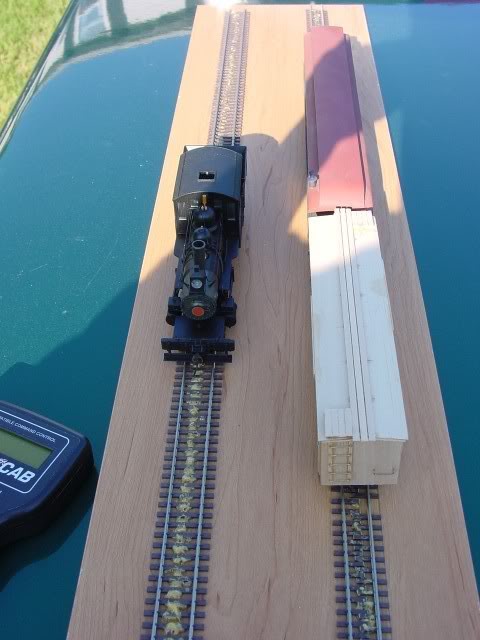
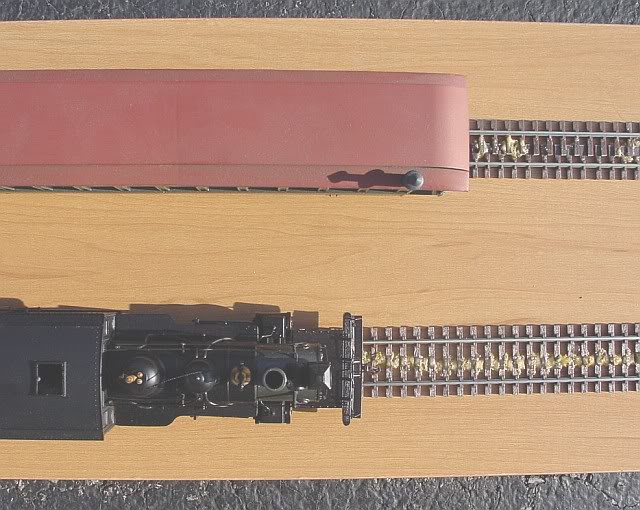
yes I know the
tie profile is all wrong..those are HO scale standard gauge ties.
but its equally
wrong for both! the only visual difference being the gauge.
And what about
the idea that "you almost never look at models straight-on (front) or straight-down,
you look at them
at an angle..which makes the difference in gauge less noticable"
hmmm..maybe..I
agree that the lower the viewing angle the less of the gauge width you
will see..
and if you are
viewing at track-level, you cant see the width of the gauge at all!
If you build a
shelf layout at eye level, always viewing your trains at the angle in the
photo below,
then no problem!  The exact gauge is unimportant then.
The exact gauge is unimportant then.
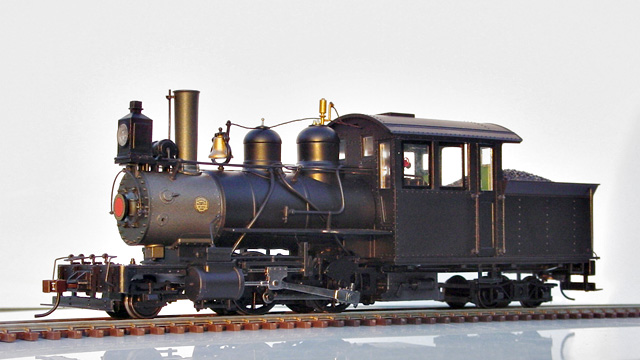
So in that sense,
there is some merit to that idea...but model railroads are often viewed
from a much
higher level
than are real railroads..we are generally "flying high above" our model
railroads as we
view and operate
them...so sorry, but I cant quite accept that arguement either! 
even at slightly
above and at a 45 degree angle..I can still see it, and it still bothers
me.
Below is a fairly
typical "model railroad viewing angle", using the real WW&F No. 9

"Mouse over" the
photo above to toggle between 24" gauge and 31" gauge.
(Prototype
photo of WW&F #9 by Chester Louis, used by permission..thanks Chester!)
As I said..I really
have nothing against On30!
If it were not
for On30, I wouldnt even have this forney to regauge to On2!
And I wouldnt
even be modeling Maine 2-footers in On2 at all....so On30 is definately
my friend...
Im simply giving
my
reasons for regauging to On2..and sharing those reasons for anyone who
might be "on
the fence"...the great thing about model railroading is..there is no wrong
answer! 
And..speaking
of "no wrong answer"...if even after reading my "reasons for On2" above,
you
still arent convinced
that regauging to On2 is the route for you, and you prefer to keep your
track
gauge at On30,
ckeck out this great
post on the On2 forum, by Don Mason, for some well thought
out reasoning
for modeling Maine 2-footers in On30!
thanks Don!
January 25, 2008.
the project begins!
Ok then..so I
think its been well established that im going to regauge everything to
On2!
that decision
has been made..there is no turning back now!
So I got a forney,
outside frame, and am ready to get to work! 
First, some photos
in the engine in its original, unmodified form, straight from Bachmann:
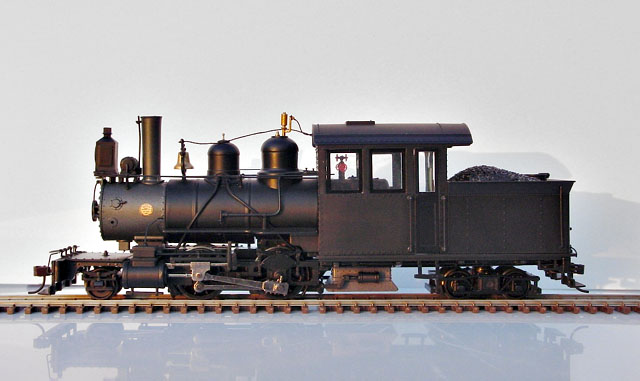

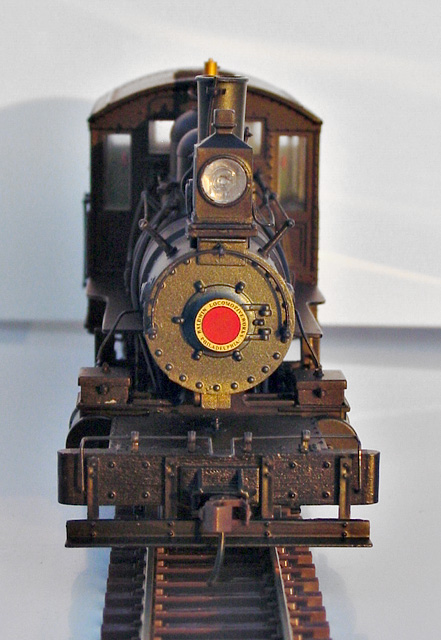
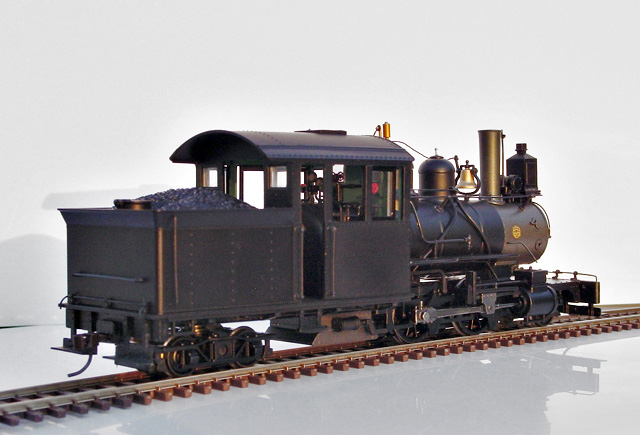
So first, lets
compare the real SR&RL No. 9 with the model to see what mods need to
be done:

(the model photo
is flipped..its actually a photo of the left side)
Obviously the
largest mod is going to be the regauge to On2!
but Bachmann
made such an accurate model, that nearly all the other major dimensions
are fine as-is!
The On2
group was worried for awhile, before the model came out, that
the forney might end up being too wide overall, because of On30 scale,
(wider track, wider everything else?) but this turned out not to be the
case! 
ONLY the gauge
is "too wide"..the rest of the engine is spot-on for 1/48 scale! very nice..
First modification
I made was the tender truck.
Bachmann offers
two versions of the truck, "heavy" and "light" versions.
both are prototypically
accurate, depending on the prototype engine being modeled.
I could only
get the undecorated forney with the "light" truck, and I needed the "heavy"
truck for No. 9!
so I swapped
tender trucks with Ken from Mount
Blue (thanks Ken!), who had the heavy but needed the light,
so thats good
to go.
Other obvious
mods:
I bought a new
wood pilot kit from Mount Blue
Model Co.
pilot truck will
be moved back slightly. (pilot truck sticks out a bit too far)
will need a new
headlight.
at first I thought
the smokebox was too long, and the domes too high.
but comparing
to the drawing shows this is not the case!
its really some
kind of odd optical illusion with the smokebox length, because just looking
at photos, the
model's smokebox looks obviously longer than the real No. 9!
but it isnt...weird.
The cab will need
some work..originally I ordered the steel cab version because of the door
placement,
even though the
real No. 9 had a wood cab when built.
(she later had
a replacement steel cab, and a different style tank) (Im going to model
No. 9 "as built")
The door placement
on the bachmann steel cab version matches No. 9 "as built",
the bachmann
wood cab does not.
but even though
I specifically ordered the cab with the correct door placement,
its going to
end up not making any difference..
because I think
I will scratchbuild new cab sides, to get the windows and the wood paneling
correct.
Will also require
a new "three window" panel across the front of the cab.
I can keep the
cab roof and lower it back down onto the new cab sides...maybe.
The cab/tender
deck is sitting just a touch too high..not sure how im going to fix that
yet.
But thats basically
it! 
nothing super-major..and
much
easier than my #23
bash!
A
history of Number 9, and the changes through her lifetime:
Here are a bunch
of observations about Number 9 I made by looking through 4 different books:
this is copied
from a post and discussion on the On2 group.
(starting with
post 8155..and running through early March..the topic splits a bit)
Two feet between
the rails, Volume 2, by Robert Jones.
The Maine Two-Footers,
by Linwood Moody. (2nd edition, 1998 version.)
The Maine Scenic
Route, by H.T. Crittenden
Maine two foot
gauge forneys, Volume 2, by Peter Barney.
Based on the photos,
I have come up with 4 distinct "phases" for Number 9..
(please note
that these "phases" are totally arbitrary! invented by me, and are in no
way "official"..
also, they are
subject to change! ;)
Phase 1
1909 to ~1912
Number 9 "as built",
new from Baldwin in 1909.

Wood cab.
Flared tank.
Russia Iron boiler.
Color scheme
- (I have a major surprise concerning paintschemes coming soon!)
Photos for phase
1.
Builders photo
(linked above)
Jones page 36
(bottom)
Jones page 37
there is also
a photo of "Phase 1" at the very bottom of this page.
Phase 2
somewhere between 1909 and 1912
new paintjob
and first small detail changes.
Same as Phase
1, except for:
New Paintjob,
colors likely Black & 1stclass.
New tender lettering,
no tender striping.
Silver smokebox.
Dome number and
dome striping are gone.
Round grabiron
added to smokebox front.
New cab doors.
(Original cab
doors slid back along outside of cab,
new cab doors
are hinged and swing inward.)
Photos for phase
2:
Jones page 36
(top)
Jones page 82
Jones page 114
(Frame bend/sag visible..she kept this until the end)
Phase 2b
~1912 to ~1920
- new pilot.
Same as phase
2, except for:
All new pilot.
Pilot steps added.
all new "cowcatcher"
with new staves.
Knuckle coupler
replaces original link and pin.
coupler release
lever.
pilot beam cut
flush with edge of pilot deck.
New cab grabs,
(both side of door)
New tender grab
(rear of tank sides)
Rear tank step.
appears to be
same paintjob as phase 2.
Photos for phase
2b:
Jones page 50
Barney page 41
Moody page 119
(im calling it
phase 2b because its nearly the same as phase 2,
except for the
new pilot, and small detail additions...same
paintscheme as
phase 2, with the silver smokebox.)
It is believed
that phase 2b occured around 1912.
quote from Ray
Christopher on the On2 forum:
"I believe phase
2 and 2a happened very close together, around 1912.
Government mandated
safety appliances were required by that year including
handrail and
step upgrades. The law was passed years earlier but SR&RL seems to
have put these
off until the very end of the grace period. I believe they were
not installed
until shortly after the Maine Central takeover."
-Ray Christopher
Thanks Ray!
This indicates
that Number 9's original as-delivered Baldwin paintscheme lasted a very
short time!
only 1 to 3 years..because
she was clearly repainted by the time she recieved knuckle couplers and
a new pilot,
around 1912..Why
she was repainted so quickly is a mystery...and her phase 2, 3, and 4 colorsheme
is almost
certaintly the
"Black & 1stclass" scheme, which was standard after the Maine Central takeover
in 1912.
(The Maine Central
controlled the SR&RL between 1912 and 1923)
Perhaps there
was a mandated repaint for all locomotives in 1912? whether they needed
it or not?
perhaps..but
thats just a guess at this time.
Also, if the 1912
date for the first repaint is correct, (which im confidant it is)
it appears the
original Baldwin lettering and striping faded away VERY quickly!
Look at the photo
at the very bottom of this page.
If that photo
is between 1909 and 1912, Baldwin had some issues with their paint quality!
Between 1909
and 1912, the tender striping and lettering almost faded away to nothing!
in only a few years time.
This could have
also been a factor in her quick repainting of the original scheme.
Whatever caused
her quick repaint, she sadly wore her original colors a very short time
it seems.
Phase 3
1920 to 19??
New steel cab,
and air tanks, but original flared tender.
Phase 3 adds:
A new steel cab,
replacing the original wood cab. (perhaps steel plating over the original
wood cab.)
however the original
flared tank is NOT yet replaced.
Generator on
top of smokebox.
Late "angled"
style headlight. (electric)
Airtanks on side,
with walkways raised.
Nearly all her
"Late" details in place, except for the new tender tank.
Phase 3 and 4
also have the 3rd version of the pilot.
a new pilot beam,
with rounded edges, sticking out beyond the edge of
the pilot deck..it
appears the rest of the pilot from Phase 2 was
re-used, same
cowcather staves, same steps, same coupler pocket.
Just re-bolted
to the new pilot beam.
"Air brakes fitted
to Number 9, February 1920" - crittenden page 174.
Since phase 3
has the air tanks, this would indicate phase 3 and 4 are
after 1920.
Photos for phase
3:
Jones page 100
Jones page 185
Phase 4.
19?? to 1936
Number 9's last
configuration.
This is usually
what is referred to as "Late" when models of Number 9
come in "early"
and "late" versions..such as the brass forneys.
Same as Phase
3, except with the addition of the "Late" tender tank.
the non-flared
replacement tank.
exact date this
tank was added is currently unknown.
Click here
for a photo of a Phase 4 On2 brass model. (commonly known as "Late" configuration.)
Photos of phase
4:
Jones page 232
242
257
268
293
348
Barney pages
44-45, dated 1934.
Barney page 46
Moody page 33
Crittenden Fig
98, 1934.
Paintscheme for
phases 2, 3 and 4 almost certaintly Black with Chromium Yellow lettering.
Two major roundhouse
fires, that number 9 was NOT involved in.
(it was postulated
that perhaps Number 9's cab and tank changes were the result of one of
these roundhouse
fires..this appears not to be the case.)
Rangeley roundhouse
fire, October 3, 1917.
Locomotives 10
and 21 damaged.
Phillips Roundhouse
fire, February 12, 1923.
(my birthday!
- 46 years later)
Nine locomotives
in the roundhouse:
6,8,16,17,18,19,21,22,23.
only 6 and 23
pulled out, the rest damaged.
15 was at the
Phillips paintshop.
9 and 24 were
at Kingfield.
10 was at Rangeley.
(Crittenden page
177.)
Number 9, along
with Number 18, were the last two locomotives operating on the SR&RL.
Number 18 was
the main power for the "scrap trains"..hauling the flatcars as rails were
removed
throughtout the
system in 1935. Number 9 was kept in reserve as backup for number 18.
After all rails
were removed all the way to Farmington, Number 9 and 18 were scrapped where
they sat, in
Farmington, in 1936.
Number 24 survived
a year longer, but was not used on the scrap trains, because she was bought
a few months
before "the end" by a railfan and put in storage. The railfan unfortunately
couldnt afford to keep her,
had nowhere to
move her, so 24 was also sold for scrap in 1937..
The only surviving
SR&RL locomotive is SR&RL number 6, which was originally Sandy
River number 5.
Number 6 was
sold to the Kennebec Central in 1925, 10 years before the end, becoming
KCRR #4.
She then went
to the WW&F in 1933, recieving her fourth and last number change, becoming
WW&F No. 9.
Today Sandy River
number 5 of 1891 exists at the WW&F
Railway in Alna, Maine.
the one and only
surviving Portland Forney.
Alas, not one
of the SR&RL's big Baldwins escaped the torch.
and thats everything
I have for now..
Corrections are
VERY welcome!
Im sure I have
some of this wrong..
and there is
still a lot unknown about these various "phase transitions"..especially
the dates!
thanks,
Scot
 Onward
to Page 2 Onward
to Page 2
Quick Jump to individual pages:
Page 2 - Deconsructing
the Forney, and thoughts on "how to regauge".
Page 3 - The new
cab.
Page 4 - The regauged
frame.
Page 5 - Work continues.
 back
to my On2 projects page back
to my On2 projects page
 back to my main page.
back to my main page.
|














